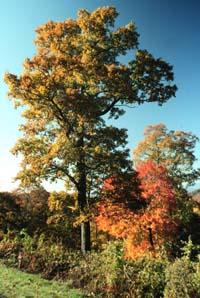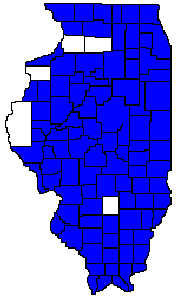 |
| Red
Oak (Quercus rubra)
Distribution
Map to Right |

Red oak, or northern red oak is a medium to tall tree, reaching a potential height of approximately 60-90 feet at maturity. The trunk is broad, reaching two to three feet in diameter on the largest of trees, and may flair outward slightly at the base. The large, spreading branches form a broad crown. Red oak is relatively fast growing on good soils and requires high light levels to grow.
It occurs in mesic upland forests on rich, well-drained soils. It can occasionally be found in wetter upland forests and on dry slopes, however. It is present in almost every county in Illinois.
Interesting
Facts
Red oak
reproduces from both seeds and root sprouts. Its seedlings do not tolerate
shade. They require a gap in the canopy to grow to maturity. Red oak is
a rapidly growing, long-lived tree. The oldest of the red oaks may live
to 300 to 500 years of age, but these are the exceptions. The average age
of most red oaks today is less than that.
Identifying Features
BarkUses
The bark ranges in color from a brownish gray to dark gray, and has wide ridges separated by shallow fissures.
Twigs
The twigs are slender, reddish-brown, and smooth.
Buds
The buds, which are terminal, are dark reddish brown and smooth.
Leaves
The ovate to elliptical leaves are alternate and have 7 to 11 shallow, bristle-tipped lobes (the lobes are incised less than half the distance to the midrib of the leaf). They are 5 to almost 10 inches long, and from 5 to 7 inches wide. The leaf stalk is often slightly red. The surface of the leaves is dark green and the underside is paler green. Both surfaces are often smooth but may have minute hairs, especially along the veins on the underside of the leaf. The veins are usually raised on both surfaces of the leaf.
Flowers
Male and female flowers occur on the same tree as separate flowers. The male flowers are typical of the oaks, and appear in the spring just before leaf out as drooping, yellowish catkins. The female flowers appear in clusters of 1 to 3, and are small, red, and without petals.
Fruits
Acorns are produced biennially. They can occur singly or in pairs, with or without stalks. They are light brown and about 1.5 inches long. The reddish brown cap is saucer shaped and covers less than a quarter of the nut.
Red oak has light-colored, hard, close-grained wood that is used for a variety of purposes from fence posts and flooring to furniture. Native Americans used red oak for medicines to treat a variety of ailments, including digestive disorders, respiratory diseases, and skin infections.